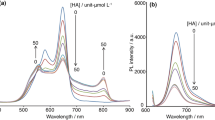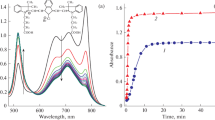Abstract
The absorption and circular dichroism (CD) spectra of three types of cyanine dyes with different lengths of methine group (3,3′-diethylthiadicarbocyanine iodide, DTDC; 3,3′-diethylthiacarbocyanine iodide, DTC; and 3,3′-diethylthiacyanine iodide, DTTHC) in an aqueous solution were compared with and without hyaluronic acid (HA), which has a helical structure. DTDC forms chiral H- and J-aggregates, whereas DTC and DTTHC are unable to form any aggregates. DTDC also forms H- and J-aggregates in the presence of sodium polyacrylate (PA) with a random-coil structure; however, the PA-DTDC aggregates exhibit no chirality. These results suggest that the chirality of HA-DTDC aggregates is induced by the helical structure of HA. In 2.4 vol% and 10 vol% methanol, HA-DTDC aggregates displayed different patterns of temperature dependence, whereas no aggregation was observed in 30 vol% methanol. The solubility of DTDC in a mixed solvent of water and methanol is generally improved by the addition of methanol, which prevents the aggregation of DTDC.
Similar content being viewed by others
References
I. Hargittai and M. Hargittai, Molecular structure of hyaluronan: an introduction, Struct. Chem., 2008, 19, 697–717.
I. C. M. Dea, R. Moorhouse, D. A. Rees, S. Arnott, J. M. Guss and E. A. Balazs, Hyaluronic Acid: A Novel, Double Helical Molecule, Science, 1973, 179, 560–562.
J. K. Sheehan and E. D. T. Atkins, X-ray fibre diffraction study of conformational changes in hyaluronate induced in the presence of sodium, potassium and calcium cations, Int. J. Biol. Macromol., 1983, 5, 215–221.
S. Arnott, A. K. Mitra and S. Raghunathan, Hyaluronic Acid Double Helix, J. Mol. Biol., 1983, 169, 861–872.
A. Almond, P. L. Deangelis and C. D. Blundell, Hyaluronan: the local solution conformation determined by NMR and computer modeling is close to a contracted left-handed 4-fold helix, J. Mol. Biol., 2006, 358, 1256–1269.
V. Gargiulo, M. A. Morando, A. Silipo, A. Nurisso, S. Pérez, A. Imberty, F. J. Cañada, M. Parrilli, J. Jiménez-Barbero and C. D. Castro, Insights on the conformational properties of hyaluronic acid by using NMR residual dipolar couplings and MD simulations, Glycobiology, 2010, 20, 1208–1216.
H. Ihara, M. Shibata and C. Hirayama, Molecular recognition using cyanine-α-helical poly (L-lysine) complexes in methanol, Chem. Lett., 1992, 1731–1734.
J. L. Seifert, R. E. Connor, S. A. Kushon, M. Wang and B. A. Armitage, Spontaneous assembly of helical cyanine dye aggregates on DNA nanotemplates, J. Am. Chem. Soc., 1999, 121, 2987–2995.
A. L. Stadler, B. R. Renikuntla, D. Yaron, A. S. Fang and B. A. Armitage, Substituent Effects on the assembly of helical cyanine dye aggregates in the minor groove of a DNA template, Langmuir, 2011, 27, 1472–1479.
T. M. Akimkin, A. S. Tatikolov, I. G. Panova and S. M. Yarmoluk, Spectral study of the noncovalent interaction of thiacarbocyanine dyes with hyaluronic acid, High Energy Chem., 2011, 45, 515–520.
T. Sagawa, H. Tobata and H. Ihara, Exciton interactions in cyanine dye–hyaluronic acid (HA) complex: reversible and biphasic molecular switching of chromophores induced by random coil-to-double-helix phase transition of HA, Chem. Commun., 2004, 2090–2091.
J. Ghasemi, A. Niazi, G. Westman and M. Kubista, Thermodynamic characterization of the dimerization equilibrium of an asymmetric dye by spectral titration and chemometric analysis, Talanta, 2004, 62, 835–841.
M. Kasha, H. R. Rawls, M. Ashraf El-Bayoumi, The exciton model in molecular spectroscopy, Pure Appl. Chem., 1965, 11, 371–392.
K. Sayama, S. Tsukagoshi, T. Mori, K. Hara, Y. Ohga, A. Shinpou, Y. Abe, S. Suga and H. Arakawa, Efficient sensitization of nanocrystalline TiO2 films with cyanine and merocyanine organic dyes, Sol. Energy Mater. Sol. Cells, 2003, 80, 47–71.
K. Sayama, S. Tsukagoshi, K. Hara, Y. Ohga, A. Shinpou, Y. Abe, S. Suga and H. Arakawa, Photoelectrochemical Properties of J Aggregates of Benzothiazole Merocyanine Dyes on a Nanostructured TiO2 Film, J. Phys. Chem. B, 2002, 106, 1363–1371.
P. W. Staskus, W. C. Johnson Jr., Conformational transition of hyaluronic acid in aqueous-organic solvent monitored by vacuum ultraviolet circular dichroism, Biochemistry, 1988, 27, 1522–1527.
Author information
Authors and Affiliations
Corresponding author
Additional information
Electronic supplementary information (ESI) available. See DOI: 10.1039/c5pp00343a
Rights and permissions
About this article
Cite this article
Tobata, H., Sagawa, T. Specific excitonic interactions in the aggregates of hyaluronic acid and cyanine dyes with different lengths of methine group. Photochem Photobiol Sci 15, 329–333 (2016). https://doi.org/10.1039/c5pp00343a
Received:
Accepted:
Published:
Issue Date:
DOI: https://doi.org/10.1039/c5pp00343a




